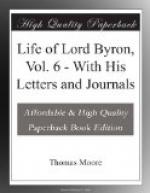Of sculpture I have just spoken. It is the great scope of the sculptor to heighten nature into heroic beauty, i.e. in plain English, to surpass his model. When Canova forms a statue, he takes a limb from one, a hand from another, a feature from a third, and a shape, it may be, from a fourth, probably at the same time improving upon all, as the Greek of old did in embodying his Venus.
Ask a portrait painter to describe his agonies in accommodating the faces with which nature and his sitters have crowded his painting-room to the principles of his art: with the exception of perhaps ten faces in as many millions, there is not one which he can venture to give without shading much and adding more. Nature, exactly, simply, barely nature, will make no great artist of any kind, and least of all a poet—the most artificial, perhaps, of all artists in his very essence. With regard to natural imagery, the poets are obliged to take some of their best illustrations from art. You say that a “fountain is as clear or clearer than glass” to express its beauty:—
“O fons Bandusiae, splendidior vitro!”
In the speech of Mark Antony, the body of Caesar is displayed, but so also is his mantle:—
“You all do know this mantle,” &c.
* * * * *
“Look! in this place ran Cassius’ dagger through.”
If the poet had said that Cassius had run his fist through the rent of the mantle, it would have had more of Mr. Bowles’s “nature” to help it; but the artificial dagger is more poetical than any natural hand without it. In the sublime of sacred poetry, “Who is this that cometh from Edom? with dyed garments from Bozrah?” Would “the comer” be poetical without his “dyed garments?” which strike and startle the spectator, and identify the approaching object.
The mother of Sisera is represented listening for the “wheels of his chariot.” Solomon, in his Song, compares the nose of his beloved to “a tower,” which to us appears an eastern exaggeration. If he had said, that her stature was like that of a “tower’s,” it would have been as poetical as if he had compared her to a tree.




